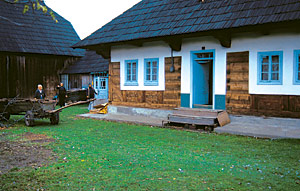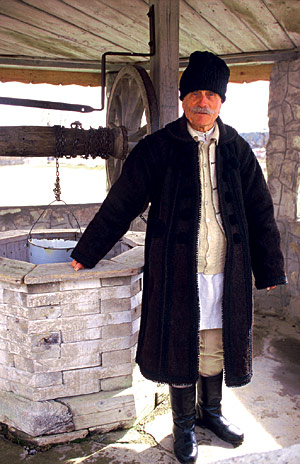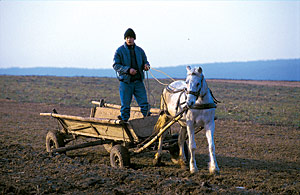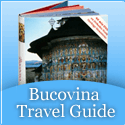Traditions and Customs – Bucovina
Pictures Traditions and Customs in Bucovina

All photos and illustrations are taken from the Bucovina travel guide where they can be seen in high quality.

Summary: Life in the rural environment is simple and complex at the same time: people still follow strict rules of behaviour and maintain ancient traditions, but modern life brings conflicting values even to the remotest villages. A land harmoniously inhabited by various nationalities, Bucovina has withstood the most radical transformations of time and fashion, and has preserved its unforgettable way of life.

A typical farmyard in Bucovina generally includes the main house opposite the gate, the summer kitchen to the right, the stable and hay barn to the left, a lower shed between the house and the barn, and a well and a kennel. When several generations live within the same yard, the parents or grandparents move to the summer kitchen, which becomes a secondary dwelling, with only one room and a hall. A typical farmyard in Bucovina generally includes the main house opposite the gate, the summer kitchen to the right, the stable and hay barn to the left, a lower shed between the house and the barn, and a well and a kennel. When several generations live within the same yard, the parents or grandparents move to the summer kitchen, which becomes a secondary dwelling, with only one room and a hall.

A peasant of average means had some hectares of land on the outskirts of the village. The land around the farm was exploited for daily living, while the products obtained from the land farther away were sold, or exchanged, to assure the living of the family throughout the year. The structure of the village differs for example from a village in Neamţ, where the houses are lined along the main road, with an orchard behind the house and only a bed of flowers in front of it. In Bucovina each house has its own well in the yard, while in Neamţ a common well is found by the road.

The folk costume is still worn daily by the old, while the younger generations wear uniform western clothes. They rarely wear traditional clothes apart from special occasions. The men’s costume includes white trousers (iţari), which have long legs to fold them several times over, as protection against humidity; a white shirt with mainly geometrical embroidery in black or brown; and a waistcoat (bundiţă) with the white leather turned out and the fur turned in, decorated with floral or geometrical motifs and with marten fur trimmings. Men also wear belts, either woven or made of leather. Sometimes the leather belt is worn on top of the woollen one. The width of the belt depends on the altitude of the village – the higher up the village, the wider the belt. The future bride cut, sewed and embroidered the suit of her husband-to-be during the one-year-long engagement.
Women wear a similar waistcoat but the decoration is more colourful. The women’s shirt is richly adorned with floral or geometrical motifs. It is said that the full decoration of the Bucovinean shirts recalls the decoration of the painted churches.
Women wear one-piece wrap-around skirts (catrinţe) on top of the knee-length shirt, tied with a wide woven belt.
There are specific clothes for the cold seasons, autumn and winter. The suman, used in autumn, is made of a very thick woollen felt cloth. The cojoc, is a knee-length fur coat, with the fur turned inside and the skin outside, decorated with embroidered flowers.

The people of Bucovina not only greet strangers, but also offer a place to sleep, not for financial gain but because they are hospitable, and consider it an honour to open the door of their house. And when hungry, the best traditional dishes are served – mămăligă (maize polenta) with fresh cheese and cream, eggs, pork sausages, sarmale (cabbage or vine leaves stuffed with meat and rice), yoghurt, soup or răcituri (jellied meat). Nearly all food is heavy, and digestion is helped with a glass of ţuica (plum brandy). This is the only alcoholic drink commonly used, and is often drunk from the same glass by everybody at the table.
Various soups and borş (soup soured with fermented husk of wheat) are eaten every day. A thick mixture of boiled wheat grain, colivă, a patty-like cake for commemorating the dead is still prepared and eaten on special occasions.
Oven-baked dishes are usually flour-based cakes and pies. In poale-n brâu -pies, cheese is wrapped in dough, in vărzări, cabbage is used instead as filling (varză=cabbage). Of the traditional Easter baked goods, pască is specific to the countryside and cozonac has its roots in the towns. Pască is made of a rolled out sheet of yeast dough, covered with a mixture of cottage cheese, cream, eggs and sugar, decorated with a figure of a cross made with the dough, and baked in a round tin. Cozonac is made of a sheet of the same dough, covered with nuts, rolled and baked in a high tin.

The people of Bucovina are famous sheep and cow breeders, and make very good milk products, which within the region of Moldavia face competition only from those made in the zone of Neamţ. Both Suceava and Neamţ are hilly, with an altitude of 400 m – 1,000 m, with beautiful meadows and good grass. The pastoral year starts in April and ends in October. During this period the sheep stay at the sheepfold, outside the village, under the care of a shepherd. The owners of the sheep receive milk and cheese periodically, depending on the number of their sheep. The shepherds are paid in produce rather than money.

The same way of bartering was also used at flour mills when grinding grain, or at wine presses when crushing raisins. Nowadays, modern wine presses can be found in almost every house, but flour mills are owned by small companies, and the payment is partly in flour and partly in money.
Bucovina is also known for its well-bred domestic birds and pigs, as well as for its excellent potato, cabbage, cauliflower and fruit crops, especially apples, pears, plums and cherries. Cereals are also cultivated, but the crop is mainly meant to cover the requirements of the homestead. Wood processing has always been one of the main occupations in Bucovina.
{tours-banner-scroll}

The life of the Romanian peasant has always been structured around the yearly cycle of labour, agriculture, animal husbandry, hunting, fishing and beekeeping. The life of a peasant has always meant making the land productive, not with the aim of becoming rich, but simply to assure a good living for his family. The yearly cycle is also followed in traditions and beliefs, many related to a good crop and placating the spirits.
Among the most important traditional beliefs are the ancestors’ spirits, which are said to return among the living during the winter holidays from Christmas to Epiphany. They do not come with harm in mind and are paid due respect. This belief is mainly visible in the mask playing tradition of this time of the year, with the Old Man and the Old Woman the most usual personages. If these spirits delay the return to their own land there is a risk that they could turn dangerous. In order to chase them away, garlic is put at the windows of the houses. The same mask playing tradition recounts also beliefs in the supernatural powers of animals, such as the bear (symbolizing protection and strength), the goat, the ram, the ostrich, which are represented with realistic masks.
Pictures Traditions and Customs in Bucovina


 Neamt County
Neamt County Travel Maramures
Travel Maramures Rustic Traditional Houses
Rustic Traditional Houses Oltenia – Traditions
Oltenia – Traditions







